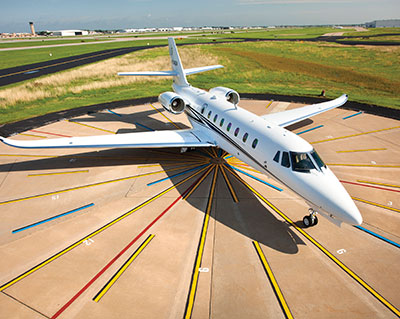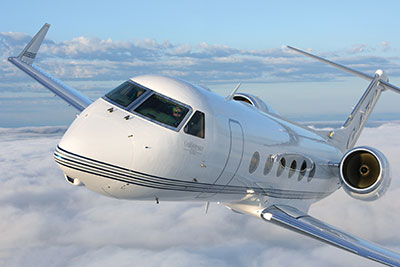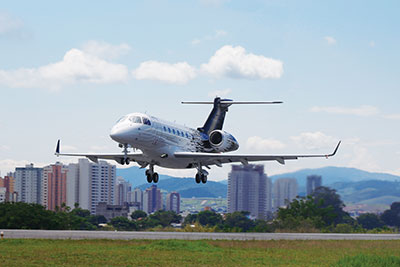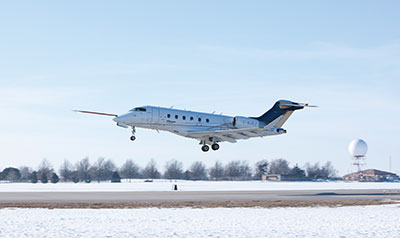
Features
Operations
Emerging from the clouds
After years of somewhat sluggish activity, there’s some very encouraging news for the Canadian business aviation sector according to some recently released business aviation market reports.
January 10, 2014 By David Carr
After years of somewhat sluggish activity, there’s some very encouraging news for the Canadian business aviation sector according to some recently released business aviation market reports.
 |
|
| A Honeywell report says NetJet’s large order of 225 aircraft from Bombardier and Cessna last year boosted backlog figures. Photo: Cessna
|
According to the latest Honeywell annual Business Aviation Outlook released during the 2013 National Business Aviation Association’s annual convention in Las Vegas, business jet deliveries are expected to regain some traction this year after dipping slightly in 2013 because of delays in several aircraft development programs.
“2014 industry deliveries are anticipated to be up modestly, reflecting recovery in supply-side constraints and some gains linked to the projected pace of global economic recovery,” said Rob Wilson, president of Honeywell Business and General Aviation. A recent Bombardier forecast aligns with the Honeywell report for 2014 and predicts that the industry will surpass its prior delivery peak year of 2008 by as early as 2016. Swedish-based Avinode, an aviation business intelligence leader, also predicted positive news for North American BizAv markets in 2014, targeting a .7 per cent increase in traffic.
Leading the pack
Over the longer term, Honeywell sees four to five per cent average annual industry growth over the next decade, with the North American market pulling the global industry out of the doldrums, at least for the next five years, although not before 2015, and possibly not at all if a strong global economic rebound fuels growth in other regions.
Results in the Honeywell report dovetail nicely with those shared by Bombardier. According to the Montreal-based OEM’s forecast, “North America will receive the greatest number of new business jet deliveries between 2013 and 2032.”
During the next five years, roughly 61 per cent of projected demand for new business jets will come from North American operators, up eight points from the 2012 survey. Latin America is expected to account for 18 per cent, while Europe will account for 12 per cent. Despite strong growth in business aviation in certain emerging markets, Asia Pacific and Middle East/Africa appear to have gone cold and will account for only five per cent or less of the projected demand each.
Holding back the North American sector have been deferrals of investment in new and more fuel-efficient models. The average age of a business jet in North America is approximately 17 years. Honeywell reports that the industry’s “mainstay market” has seen new jet purchase plan levels improve by about three points, although short-term conversion plans could be moderate for at least the next year.
Breakout figures for 2013 are unavailable, but the Canadian market accepted six per cent of North American deliveries in 2012, and the Canadian business aviation sector has almost doubled its fleet in the past 10 years.
“North America represents more than half of projected global demand for the next five years based on the region’s historically dominant installed business jet base, affirming the region’s indisputable important to the industry’s future,” the report noted.
The North American market also has the most balanced preference for various business jet types. Large-cabin and long-range jets will account for 50 per cent of all aircraft delivered. Small cabin aircraft will make up 29 per cent of orders, the largest share of any region.
White hot options
Up to 9,250 deliveries of new business jets, valued at more than $250 billion are expected until 2023. However, it is not the number of units sold, which is down 750 aircraft in a year-over-year comparison, but the dollar value of the purchase orders, which is up four per cent because of inflation and a shift toward larger cabins and extended range.
 |
|
| In mature markets such as Canada and the United States, the globalization of trade, fleet renewal and new aircraft programs will continue to set the pace for future growth.
|
“The trend toward larger-cabin with ever-increasing range expectations and advanced avionics is seen more strongly than ever in this year’s survey,” said Wilson.
Indeed, range followed by bigger cabin topped out the Honeywell survey for new jet models in all five regions (North America, Europe, Latin America, Asia, and the Middle East and Africa). And that’s good news for Bombardier, which excels in both range and cabin. The Canadian airframer, however, appears to have its work cut out for it in the longer term with high-growth China, a ripe market for long-range airplanes where appeal by brand seems to have slipped under the Honeywell radar, because China’s airplane of choice remains Gulfstream.
Bombardier currently has more than 100 business jets in the Greater China Region, and recently announced it will open a commercial and business aviation maintenance, repair, and overhaul facility in Tianjin, China in 2016.
Over the next 10 years, big cabin, which is defined as super midsize through business liner classes will account for 56 per cent of every airplane sold, and an eye-popping 83 per cent of revenue.
Key elements that drive growth
Growth in business jet acquisitions is being pinned on a series of drivers. Wealth creation is certainly fuelling demand in emerging markets such as the BRIC economies, although the results here are somewhat mixed. In China, high wealth creation and global business growth are also coaxing out first-time buyers, compared with Russia, where weak purchase expectation forecasts in the latest Honeywell survey are a drag on Europe and where growth has slowed over the near term and is expected to continue. “Worldwide demand for business jets is highly correlated with wealth creation,” said Bombardier in its business jet market analysis.
 |
|
| Embraer’s Legacy 500 is expected to make its entry into the business aviation market this year. Photos: Embraer
|
In mature markets such as Canada and the United States, the globalization of trade, fleet renewal and new aircraft programs will continue to set the pace for future growth, the Bombardier report notes. The availability of more capable aircraft creates demand for replacement aircraft and entices first-time buyers to enter the market. New arrivals for 2014 include Bombardier’s Challenger 350 and Learjet 85, the new Citation Sovereign, Dassault Falcon 2000 LXS and Embraer Legacy 500.
A key indicator of fleet renewal is the hardening of the pre-owned market. Honeywell sees a slight uptick in this sector, but performance is still far below what it was five years ago. “The number of pre-owned jets for sale today has risen slightly from a year ago. Approximately 12.5 per cent of today’s fleet is up for resale, down from a high of nearly 16 per cent reached in 2009.”
Accessibility through fractional ownership and charter operations will continue to impact flight activity but has not yet bolstered the order book, according to Honeywell. But this could certainly change. “Flight activity for charter-like operations and fractional ownership appears to be doing relatively well in the U.S. but not translating into many new aircraft deliveries yet. Fractional operators have taken only 20 new jets this year. NetJet’s large order of 225 aircraft from Bombardier and Cessna last year boosted backlog figures, and additional orders should impact delivery performance favourably beginning in 2014.”
 |
|
| Bombardier’s Challenger 350 sports a range of 3,200 nautical miles at a cruising speed of Mach .80 while carrying eight passengers. Photos: Bombardier
|
After a sluggish five years where orders actually shrank, Bombardier estimates that fractional operators will account for 10 per cent of deliveries over the next 20 years. Demand from existing fractional operators comes mainly from fleet replacement. Demand for incremental airplanes will come from markets where fractional ownership is just being introduced. China launched its first fractional ownership service in 2013.
“We continue to see underlying macro-trends that support potential demand for business jets, making the industry’s long-term prospects attractive,” Honeywell’s Wilson said. “Other factors we believe will help accelerate global business aviation growth are long overdue structural and regulatory reforms, which have the potential to unlock significant spending power that would propel aviation expansion. New products also increase demand.”
Benefits to Canadian manufacturing
Bombardier has the broadest mix of business jets in the industry, and is well positioned to capture a leading share of orders going forward, which bodes well for the broader Canadian aerospace manufacturing sector, including engines, landing gear and avionics. “Bombardier’s greatest opportunities come from its leading business jet position,” according to the Teal Group, a Fairfax, Virginia-based aerospace and defense consulting firm. “Bombardier has extremely strong backlogs for its Global, Challenger and Learjet lines. Bombardier also has a number of relatively new business jet products.”
Customer challenges on the horizon
The business jet sector faces stiff challenges identical to those experienced by the airline industry, including soaring fuel prices, which some analysts predict could top $140 a barrel by 2020, and increased environmental regulation, which could impact the long-range segment, especially when flying to destinations within the European Union. Both challenges could potentially drive the aircraft replacement market.
The Honeywell survey identifies other operator concerns, including the regulatory environment (particularly duty cycles, time-of-day use restrictions), air traffic modernization efforts, and user fees and tax laws, that have the potential to dampen demand over the long term. For now at least, economic growth will trump other concerns, and demand for business jets is on the rise.